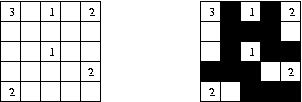Problem
At least it’s not a sudoku problem
The puzzle Nurikabe is played on a grid. Initially, each grid space is either blank or contains a single number. The goal is to shade in some of the blank spaces to satisfy the following constraints:
- Any two shaded spaces are connected by some sequence of adjacent shaded spaces. Two spaces are called adjacent if they share a side.
- For each of the unshaded spaces b, let Wb be the collection of all unshaded spaces that can be reached from b by a sequence of adjacent unshaded spaces. Then, Wb contains exactly one numbered space and that number is exactly the number of spaces in Wb.
- For any unshaded space b, there is a sequence of unshaded spaces starting at b and ending at a space on the edge of the grid where consecutive spaces in this sequence share a side or a corner.
- Finally, in every 2 x 2 subsquare there is at least one unshaded space.
The image shows an example of a Nurikabe puzzle and its solution. Take care to verify all four constraints are satisfied in the solution. To help you understand the third constraint, note that the middle cell containing the number 1 can reach the edge of the grid since it shares a corner with a group of unshaded spaces containing the number 2.

It is known that the problem of determining if a Nurikabe grid can be shaded to satisfy the constraints is NP-complete. Your task is much easier. Given an initial grid and a proposed shading, determine if the shading satisfies the constraints of the Nurikabe puzzle.
Input begins with a single integer t that indicates the number of grids to verify. The first line of each case contains three integers r,c,d where the grid has r rows and c columns (1 ≤ r,c ≤ 100). Then, d lines follow, each containing three integers r’,c’,n meaning the grid cell at location (r’,c’) contains the positive number n. The upper-left grid space has coordinates (0,0), no space receives more than one number, and no two numbered grid spaces will share an edge. Finally, the shading data is specified by r strings of c characters each (one string per line). The j’th character in the i’th row of the shading data is ‘#’ if the cell with coordinates (i,j) is shaded and ‘.’ if that cell is not shaded. Each test case is preceded by a blank line.
For each input case, output a line containing either solved or not solved to indicate whether or not the shading represents a solution to the puzzle.
Sample input
|
|
Sample output
|
|
Solution
題目描述:
- 所有陰影區域會相連 (上下左右)
- 每一個區域的數字,會恰好等於該區域的非陰影個數。
- 所有非陰影的區域,皆可以連到遊戲盤面的四邊 (九宮格連接)
- 任意 2x2 區域,至少有一個非陰影的區域。
題目解法:
能剪枝就剪枝,不然很容易 TLE。討論版面上說 DFS 比 BFS 快一些。但這裡還是用 BFS 完成。
|
|